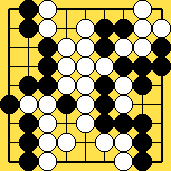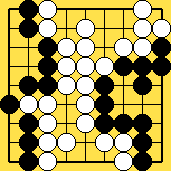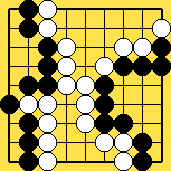
Traditional go in Korea was rather different from the versions played in China or Korea. It dates from the late 16th century, but its roots may be the version closest to the original form of go. It appears to have died out only this century. The last known game before it disappeared was played in 1937. Its recent rediscovery is due to the go writer Yi Seung-u (Lee Sungwoo), but there has also been intensive work done on both the rules and history of old Korea go by the professional Kweon Kyeong-eon 5-dan, and by An Lyeong-i, former editor of the monthly go magazine "Baduk" and of modern Korean versions of the go classics.
Old Korean go is called sun-chang pa-tuk (sunjang baduk). Sun-chang is written in two completely different ways when written in characters, indicating a basic uncertainty about the meaning, but the commonest way of writing it nowadays - touring officers - offers two possibilities. One is that it refers to a military rank and may refer to guards who moved from post to post (or are posted round the board). The other is that the 17 "star" points for the starting stones were called "guard points" (the usual term is flower points), and sun-chang refers to going round the board placing these stones at the start. The other way of writing is even more obscure but could be rendered "following one's seniors." There seems to be some connection with an administrative system introduced at the time, which relied on ranks.
As the above may indicate, the game was played on a specially marked traditional board, of which several examples survive. The 17 starting-stone points are marked. It appears that both players placed eight stones each on the points shown in the game below, and Black then played first. But as he was obliged to play his first move on the centre point, we can effectively regard this as a starting stone too. These stones have no special status, unlike their equivalents in Tibetan go. There is a ritualistic order in which they are placed but this has no bearing on the game.
The basic rules are the same as in modern Japanese go, which no doubt encouraged players to abandon the old form. For most of the first half of this century Korea was a Japanese colony and the status and strength of visiting Japanese players presumably encouraged Koreans to play the Japanese way. This trend was accelerated when senior players such as Cho Nam-ch'eol - the father of modern Korean go - established even closer links with Japan by studying there.
The real difference in sun-chang go, apart from the starting position, is in the counting rules. Ko and seki are treated exactly as in Japan (no points are counted in a seki). There was traditionally no komi, so clearly Black had a big advantage - yet another factor favouring adoption of Japanese rules. But at the time the last known game was recorded, the players were already playing each other in newspaper games using Japanese rules, and borrowed the idea of komi. The game here was perhaps even then something of an exhibition game, but it is valuable that it was played by strong players. The top 10 players at the time ranged from about 4 dan amateur to 2 dan professional in modern terms.
The method of counting requires that the game continues until all necessary dame have been filled in. As in Chinese go, dame (neutral points) is a misnomer because they can contribute to the score. Prisoners are ignored. Once the final position is reached, all dead stones are first removed (and ignored) and then all stones not forming part of the outside walls are removed. The idea is to achieve the minimum outside wall - cutting points can be left at this stage but no stone must be left in atari. The respective total territories (vacant points surrounded) are then counted and compared. The winner is the one with the highest total (after komi adjustment, if any), but it seems that there were in some areas extra provisions such that a tie was a win for White and a 1-point win for Black counted as a tie. Judging by the variant rules still extant in Korean chess we can expect some such local variations in sun-chang go.
As an example of old Korean counting, take the following 9x9 position once all moves have been played.
 |
 |
 |
| The game ended | The dead stones are first removed | Then the superfluous internal stones are removed |
Handicap play is also possible. Black occupies points on the seventh line but not the centre point, while White occupies the centre point.
The game below is the one known as the "last game." However, there have been exhibition games since then involving players as strong as Cho Nam'ch'eol. Typical first moves in their games have been K8 and K6. Games invariably become a test of nerve - though excellent training for life and death and capturing races - and that may be connected with the fact that until recent times go in Korea was largely a gambling game.
| black | white | date | place | result | #mn | game |
|---|---|---|---|---|---|---|
| Ch'ae Keuk-mun |
No Sa-ch'o |
1937-03 |
KR |
W+0.5 |
290 |
This game was published in the Chosun Ilbo newspaper in March 1937. The players were No Sa-ch'o (White) and Ch'ae Keuk-mun. Komi was 4.5 points given by Black. In the final position arranged for counting in sun-chang style Black has 57 points and White 53.
© London 1998
John Fairbairn
